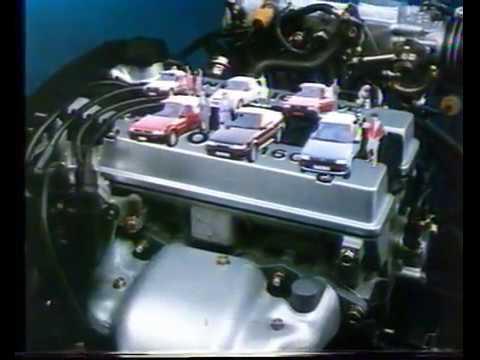When Toyota introduced their multi-valve engines early 1980s, this was advanced technology from another era. No other manufacturer, except for Triumph, was sane enough to put a multi-valve engine into a consumer car. You could argue that Nissan did the same by placing the S20 engine in the KPGC10 and the Fairlady Z432R. However, there were only a few thousand of these engines built! So when Toyota hit the market with the 1G-GE, 4A-GE and 7M-GTE in the early 1980s, this was totally out of this world! This mid-1980s European Toyota multi-valve ad boasts about them:
Toyota multi-valve technology
By the mid 1980s, the technology had matured and even basic commuter cars would be delivered with multi-valve engines. The Starlet and Corolla 2E and 3E engines received 3 valves per cylinder and this impressed the audience. But was it actually that impressive? First we need to think about what the benefits are of a multi-valve engine and why it matters.
Why do multi-valve engines perform better?
To make an engine gain more power, you need to ensure more air/fuel mixture enters the cylinder. You can achieve this by enlarging the valves of an engine. By enlarging the valves you increase the surface area of where the fuel enters the cylinder. There are some downsides though:
- Not enough surface area: the surface area is limited by the size of the head. So if you increase the valve size too much, it won’t simply fit anymore.
- Less responsive engine: another issue you will get by increasing the valve size is that these valves are getting heavier. This means they will be moving slower and the engine can’t rev high.
So the easiest fix is by adding another valve to the intake and/or exhaust. This will increase the surface area and keep similar responsiveness. I think this dinosaur video by Engineering Explained will explain it much better than I can:
Multi-valve is not the same as twin cam
Now a multi-valve engine necessarily isn’t the same as a Twin Cam engine. The earlier 1G-GE, 4A-GE and 7M-GTE were all multi-valve and Twin Cam engines. A Twin Cam engine features the opening and closing of the valves to be performed by two separate cams. One benefit for this is that the opening and closing of intake and exhaust valves can be adjusted individually. Another benefit is that a wider angle for the intake and exhaust is possible. For ordinary commuter cars this is a waste of resources and this means these three engines are actually high performance engines. Anyway, I digress here. The point that I wanted to make is that the 2E and 3E engines are multi-valve engines, but not Twin Cam. So these engines do have the benefit for increasing air velocity and allow a higher red line. However, they do not have the capability to adjust the intake and exhaust valves nor do they have a wide angle.
Conclusion
So the big question here is why did Toyota boast about the multi-valve twin cam engines in combination with the non-twin cam engines? Sales! Simply because these way more complex twin cam engines are the halo engines for those poor plebs driving commuter cars!
Bonus video with an AE86
I also have a bonus video of a 1987 Dutch Toyota multi-valve ad. The ad is very similar to the 1986 ad. There is one small difference though: instead of portraying the Supra, MR2 and Celica in now portrays the AE86 and newer AE82!
And as you may suspect already: the Youtube teaser picture shows all these cars on top of a 4A-GE engine. Unfortunately it’s in transverse orientation as the intake manifold points towards the rear of the block.

Thanks for sharing this video!